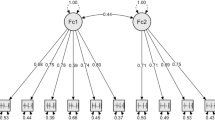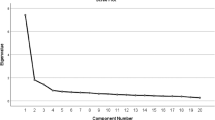Abstract
Using confirmatory factor analysis, the current study provided further evidence for the two-factor structure of the Academic Expectations Stress Inventory [AESI; Ang RP, Huan VS (2006) Educ Psych Meas 66:522–539] using a sample of 191 US Hispanic adolescents and a sample of 211 Singapore Chinese adolescents. This study also examined the cross-cultural validity of the AESI using multigroup confirmatory factor analysis to investigate the invariance of the factor structure of the AESI across both samples. Results from multigroup confirmatory factor analysis suggested that while partial invariance was observed across the samples, the consistency of fit indices indicating either no change or a minimal loss of fit between the unconstrained basic model and the partially constrained models, provided support that partial invariance was acceptable. Analyses of covariance results indicated that perceived overall academic stress and academic stress arising from self-expectations were significantly higher among Singapore Chinese adolescents compared with US Hispanic adolescents.
Similar content being viewed by others
References
Buchmann C, Dalton B (2002) International influences and educational aspirations in 12 countries: the importance of institutional context. Sociol Educ 75:99–122
Campbell RT (1983) Status attainment research: end of the beginning or beginning of the end? Sociol Educ 56:47–62
Kao G, Tienda M (1998) Educational aspirations of minority youth. Am J Educ 106:349–384
Sue S, Okazaki S (1990) Asian-American educational achievements: a phenomenon in search of an explanation. Am Psychol 45:913–920
Cheng S, Starks B (2002) Racial differences in the effects of significant others on students’ educational expectations. Sociol Educ 75:306–372
Goyette K, Xie Y (1999) Educational expectations of Asian American youth: determinants and ethnic differences. Sociol Educ 72:22–36
Trusty J (2000) High educational expectations and low achievement: stability of educational goals across adolescence. J Educ Res 93:356–365
Rumberger RW (1995) Dropping out of middle school: a multilevel analysis of students and schools. Am Educ Res J 32:583–625
Velez W, Saenz R (2001) Toward a comprehensive model of the school leaving process among Latinos. Sch Psychol Quart 16:445–467
Chung B, Kim H, Lee S, Kwon K, Lee J (1993) Restoring Korean education from the bandage of entrance examination education. Nanam Publication, Seoul
Diener E, Suh EM, Smith H, Shao L (1995) National differences in reported subjective well-being: why do they occur? Soc Indic Res 34:7–32
Abe JS, Zane NWS (1990) Psychological maladjustment among Asian and White American college students: controlling for confounds. J Counsel Psychol 37:437–444
Markus HR, Kitayama S (1991) Culture and the self: implications for cognition, emotion, and motivation. Psych Rev 98:224–253
Chen C, Stevenson HW (1995) Motivation and mathematics achievement: a comparative study of Asian-American, Caucasian-American and East Asian high school students. Child Dev 66:1215–1234
Schneider B, Lee Y (1990) A model for academic success: the school and home environment of East Asian students. Anthropol Educ Q 21:358–377
Lee S (1993) Family structure effects on students outcomes. In: Schneider B, Coleman JS (eds) Parents, their children, and schools. Westview Press, Boulder, CO, pp 43–75
Ho DYF (1981) Traditional patterns of socialization in Chinese society. Acta Psychol Taiwan 23:81–95
Yeh CJ, Huang K (1996) The collectivistic nature of ethnic identity development among Asian-American college students. Adol 31:645–662
Wong J, Salili F, Ho SY, Mak KH, Lai MK, Lam TH (2005) The perceptions of adolescents, parents and teachers on the same adolescent health issues. Sch Psychol Int 26:371–384
Salili F, Chiu CY, Lai S (2001) The influence of culture and context on students’ motivational orientation and performance. In: Salili F, Chiu CY, Hong YY (eds) Student motivation: the culture and context of learning. Kluwer Academic/Plenum Publishers, New York, NY, pp 221–248
Eamon MK (2005) Social-demographic, school, neighborhood, and parenting influences on the academic achievement of Latino young adolescents. J Youth Adol 34:163–174
Leyendecker B, Lamb ME (1999) Latino families. In: Lamb ME (ed) Parenting and child development in “nontraditional” families. Lawrence Erlbaum, Mahwah, NJ, pp 247–262
Driscoll AK (1999) Risk of high school dropout among immigrant and native Hispanic youth. Int Migr Rev 33:857–875
Raffaele LM, Knoff HM (1999) Improving home-school collaboration with disadvantaged families: organizational principles, perspectives and approaches. Sch Psychol Rev 28:448–466
Stevenson HW, Chen C, Uttal DH (1990) Beliefs and achievement: a study of Black, White, and Hispanic children. Child Dev 61:508–523
Klimes-Dougan B, Lopez JA, Nelson P, Adelman HS (1992) Two studies of low income parents’ involvement in schooling. Urban Rev 24:185–202
Hao L, Bonstead-Bruns M (1998) Parent–child differences in educational expectations and the academic achievement of immigrant and native students. Sociol Educ 71:175–198
Fuligni AJ, Tseng V, Lam M (1999) Attitudes toward family obligations among American adolescents with Asian, Latin American, and European backgrounds. Child Dev 70:1030–1044
Reyes O, Jason LA (1993) Pilot study examining factors associated with academic success for Hispanic high school students. J Youth Adol 22:57–71
Kaplan DS, Peck BM, Kaplan HB (1995) A structural model of dropout behavior: a longitudinal analysis. Appl Behav Sci Rev 3:177–193
Ang RP, Huan VS (2006) Academic Expectations Stress Inventory: development, factor analysis, reliability and validity. Educ Psych Meas 66:522–539
Cheung GW, Rensvold RB (2002) Evaluating goodness-of-fit indexes for testing measurement invariance. Struct Eq Model 9:233–255
Spencer MS, Fitch D, Grogan-Kaylor A, McBeath B (2005) The equivalence of the Behavior Problem Index across U.S. ethnic groups. J Cross Cult Psychol 36:573–589
Hui CH, Triandis HC (1985) Measurement in cross-cultural psychology: a review and comparison of strategies. J Cross Cult Psychol 16:131–152
Robert C, Lee WC, Chan K-Y (2006) An empirical analysis of measurement equivalence with the INCOL measure of individualism and collectivism: implications for valid cross-cultural inference. Personnel Psychol 59:65–99
Byrne BM (2006) Structural equation modeling with EQS: basic concepts, applications and programming. Lawrence Erlbaum, Mahwah, NJ
Byrne BM, Shavelson RJ, Muthen B (1989) Testing for the equivalence of factor covariance and mean structures: the issue of partial measurement invariance. Psych Bull 105:456–466
Marsh HW, Balla JR, McDonald RP (1988) Goodness-of-fit indexes in confirmatory factor analysis: the effect of sample size. Psych Bull 103:391–410
Bentler PM (2005) EQS 6 structural equations program manual. Multivariate Software, Encino, CA
Curran PJ, West SG, Finch JF (1996) The robustness of test statistics to nonnormality and specification error in confirmatory factor analysis. Psych Meth 1:16–29
Hu L, Bentler PM (1999) Cutoff criteria for fit indices in covariance structure analysis: conventional criteria versus new alternatives. Struct Eq Model 6:1–55
Satorra A, Bentler PM (2001) A scaled difference chi-square test statistic for moment structure analysis. Psychometrika 66:507–514
Pedhazur EJ, Schmelkin LP (1991) Measurement, design, and analysis: an integrated approach. Lawrence Erlbaum, Hillsdale, NJ
Steenkamp JBEM, Baumgartner H (1998) Assessing measurement invariance in cross-national consumer research. J Consum Res 25:78–90
Cronbach LJ, Meehl PE (1955) Construct validity in psychological tests. Psych Bull 52:281–302
Ho KC, Yip J (2003) YOUTH.sg: the state of youth in Singapore. National Youth Council, Singapore
Gillock KL, Reyes O (1999) Stress, support, and academic performance of urban, low-income, Mexican-American adolescents. J Youth Adol 28:259–282
Arnold DH, Griffith JR, Ortiz C, Stowe RM (1998) Day care interactions and teacher perceptions as a function of teacher and child ethnic group. J Res Childhood Educ 12:143–154
Lai JCL, Hamid NP, Chow P (1996) Gender difference in hassles and symptom reporting among Hong Kong adolescents. J Soc Behav Pers 11:149–164
Lee M, Larson R (1996) Effectiveness of coping in adolescence: the case of Korean examination stress. Int J Behav Dev 19:851–869
Author information
Authors and Affiliations
Corresponding author
Rights and permissions
About this article
Cite this article
Ang, R.P., Huan, V.S. & Braman, O.R. Factorial Structure and Invariance of the Academic Expectations Stress Inventory Across Hispanic and Chinese Adolescent Samples. Child Psychiatry Hum Dev 38, 73–87 (2007). https://doi.org/10.1007/s10578-006-0044-3
Received:
Accepted:
Published:
Issue Date:
DOI: https://doi.org/10.1007/s10578-006-0044-3




